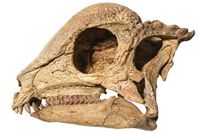In the windswept expanse of Mongolia’s Gobi Desert, a remarkable fossil discovery is rewriting the story of one of the most peculiar groups of dinosaurs: the dome-headed pachycephalosaurs. This new find, announced on September 19, 2025, and published in the prestigious journal Nature, shines a spotlight on a previously unknown species named Zavacephale rinpoche. The fossil, unearthed from the Khuren Dukh locality in the Eastern Gobi, is not only the oldest but also one of the most complete pachycephalosaur skeletons ever found, offering an unprecedented glimpse into the early history of these enigmatic creatures.
According to Reuters and corroborated by a team led by Tsogtbaatar Chinzorig of the Mongolian Academy of Sciences, Zavacephale rinpoche lived approximately 108 million years ago during the Early Cretaceous Period. Its name, blending the Tibetan word for “origin” or “root” with the Latin for “head,” underscores its significance as the earliest-known dome-headed dinosaur. The species name “rinpoche” translates to “precious one” in Tibetan, a fitting tribute to a fossil that was found perched on a cliff, gleaming like a jewel in the desert rock.
What makes this discovery so extraordinary? For starters, the skeleton is largely complete, missing only the neck, much of the ribcage, and part of the lower arm and hand. Its skull is exquisitely preserved, offering scientists a rare opportunity to study the full anatomy of a pachycephalosaur rather than just the famously thickened dome. Before Zavacephale, most pachycephalosaur fossils consisted of little more than the indestructible dome, leaving researchers with gaping holes in their understanding of these dinosaurs’ bodies, lifestyles, and evolutionary history.
The individual found was a juvenile, at least two years old at death but not fully grown—comparable in size to a German shepherd and weighing less than 10 kilograms. Despite its youth, this dinosaur already boasted a fully developed cranial dome, a feature that has long puzzled paleontologists. The dome, formed mostly by a single skull bone in Zavacephale, was encircled by small spikes and nodes along the back of the skull. This is a marked contrast to later pachycephalosaurs, whose domes were typically formed by two bones.
Researchers determined the dinosaur’s age and the timing of dome development by analyzing growth rings in its limb bones—a technique reminiscent of counting tree rings. This study marks the first time growth rings have been used to pinpoint when the cranial dome forms in a pachycephalosaur’s life. The findings challenge previous theories that domes developed only in adulthood and that juveniles had flat skulls. Instead, Zavacephale shows that dome growth began well before full maturity, echoing a pattern seen in many non-bird dinosaurs, where features for display or combat emerged during their teenage years.
The dome’s purpose remains a subject of spirited debate. Some scientists have suggested that these dinosaurs engaged in head-butting contests, much like modern bighorn sheep, to establish dominance or win mates. Others argue the domes served more as visual signals for social or sexual display. As paleontologist Lindsay Zanno of North Carolina State University and the North Carolina Museum of Natural Sciences, a senior author of the study, put it: “The consensus is that these dinosaurs used the dome for socio-sexual behaviors. The domes wouldn’t have helped against predators or for temperature regulation, so they were most likely for showing off and competing for mates.” Zanno added with a hint of admiration, “At the end of the day, you have to hand it to pachycephalosaurs. When it comes to flashy headgear, they didn’t phone it in.”
Beyond its showy skull, Zavacephale offers a trove of anatomical information. Its long, slender hindlimbs indicate it was built for speed, and its small hands and arms hint at a lightly built frame—traits that set it apart from some of its larger, later relatives. Adults of the North American Pachycephalosaurus could reach lengths of up to 14 feet (4.3 meters), but the adult size of Zavacephale was likely less than half that.
One of the most intriguing aspects of the fossil is the presence of gastroliths—stomach stones used to grind up plant material. The sharp edges of these stones, along with the animal’s fang-like front teeth, suggest an omnivorous diet, rather than strict herbivory. This aligns with the view that gastroliths were widespread among both omnivorous and herbivorous dinosaurs. The discovery of such stones in Zavacephale not only broadens our understanding of its feeding habits but also hints at the ecological diversity of early pachycephalosaurs.
The ancient environment Zavacephale called home was a valley dotted with lakes and surrounded by cliffs—a landscape teeming with other plant-eating dinosaurs, as well as fish, turtles, and crocodile relatives. The richness of this ecosystem is evident from the diversity of fossils found nearby, painting a vivid picture of life in the Early Cretaceous Gobi.
For decades, paleontologists have longed for a more complete picture of pachycephalosaur evolution. The discovery of Zavacephale rinpoche finally fills in some of those critical gaps. As Zanno explained to Reuters, “Before Zavacephale, our record of pachycephalosaurs was almost exclusively limited to their indestructible domes. With such scanty skeletons, we were left with holes in our knowledge of their anatomy, including basic things like what their arms would have looked like, how their digestive system functioned and how the cranial dome evolved over time.”
The implications go beyond anatomy. The fossil pushes back the origin of dome-headed dinosaurs by about 15 million years, challenging previous assumptions about when and how these dinosaurs evolved their signature skulls. It also provides crucial evidence for scientists trying to untangle the evolutionary relationships between pachycephalosaurs and their close relatives, the ceratopsians—a group that includes the famous horned Triceratops.
As the dust settles—both literally and figuratively—over the Gobi Desert, Zavacephale rinpoche stands as a testament to the power of paleontological discovery. Each new fossil is a window into a lost world, and this one, exposed on a cliff like a cabochon jewel, has brought the quirky, mysterious pachycephalosaurs into sharper focus than ever before.
With its exquisitely preserved skull, surprising anatomical details, and clues to ancient behaviors, Zavacephale rinpoche is poised to become a touchstone for future research into dinosaur evolution—and a reminder that there’s always more to learn, even from the most unlikely corners of the world.





